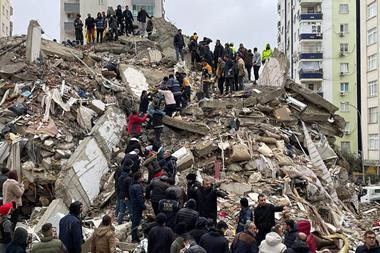These loss estimates reflect the impact of the earthquakes in Turkey only; losses in Syria are not included
Moody’s RMS estimates economic losses from the moment magnitude (Mw) Mw7.8 and Mw7.5 earthquakes that struck southern Turkey on Monday, February 6 are likely to exceed $25 billio, and the total insured loss is likely to exceed $5 billion.
These loss estimates reflect the impact of the earthquakes in Turkey only; losses in Syria are not included. The insured losses include those to private insurers as well as to the Turkish Catastrophe Insurance Pool (TCIP).
Unusual trigger sequence
Nilesh Shome, vice president of Earthquake Model Development at Moody’s RMS said: “The earthquakes ruptured geometrically complex faults with multiple branches and were part of an active sequence that included over 400 events of Mw4 or greater.
”It is very unusual for an earthquake to trigger another event of such a magnitude as the Mw7.5 earthquake. The two largest earthquakes generated significant ground motions, and many areas were impacted by both events.”
On Monday, February 6, an Mw7.8 earthquake struck east of the Turkish city of Nurdaği, triggering a strong earthquake sequence. This included an Mw7.5 earthquake that struck south-southeast of Ekinözü, Turkey.
These earthquakes occurred in southern Turkey near the northern border with Syria, causing widespread and severe damage across Turkey and northern Syria, with shaking felt as far away as Lebanon, Cyprus, Israel, and the State of Palestine.
The events ruptured multiple faults across the broad East Anatolia fault zone. The region is recognized as having a high earthquake hazard, with multiple earthquakes of Mw7.0 or greater since the nineteenth century.
Over 335,000 buildings damaged
The devastation was widespread. According to the Turkish Ministry of Environment, Urbanization, and Climate Change[1], 11 provinces were severely affected by the earthquakes, and the damage was worst in Gaziantep, Hatay, and Kahramanmaraş.
As of February 22, over 335,000 buildings are reported to have been damaged. A unique contributor to the overall loss is that most of the economic losses due to shaking can be attributed to structures with severe damage that have either already collapsed or will require demolition.
Observations from early damage reports issued by the Turkish Ministry of Environment, Urbanisation, and Climate Change, and Turkish research reconnaissance[2] indicate a systemic lack of adherence to seismic provisions, including government ‘amnesty’ programs[3] that have allowed continued occupancy of structures that do not meet seismic design requirements.
Time for resilience
Ongoing research will aim to understand the full extent of these code lapses, together with any future code updates and enforcement mechanisms that could arise from this event.
Moody’s RMS anticipates that any tightening of the codes or more stringent enforcement will likely increase repair and rebuild times, especially as the number of destroyed structures is so extensive. The damage reports to date suggest that mid- and high-rise buildings contribute significantly to the overall event loss.
The road to recovery in Turkey will take several years due to the scale of the damage, and complex macroeconomic conditions that existed prior to the events, including significant inflation, will hamper the reconstruction and add to the overall costs.
Laura Barksby, Product Manager, Moody’s RMS, concluded: “The events highlighted the devastation that can arise when large magnitude events coincide with vulnerable building stock.
”We continue to learn from each significant earthquake, and the events in Turkey act as a wake-up call for other earthquake-prone regions, particularly concerning the true quality of the building stock.”




















No comments yet